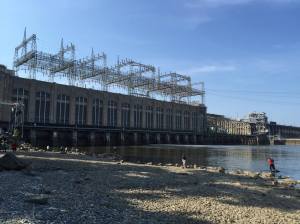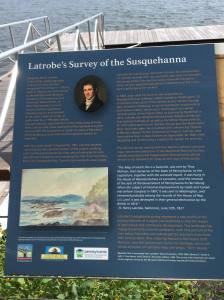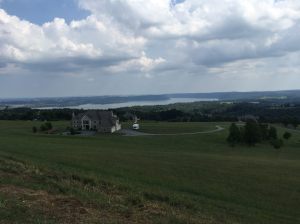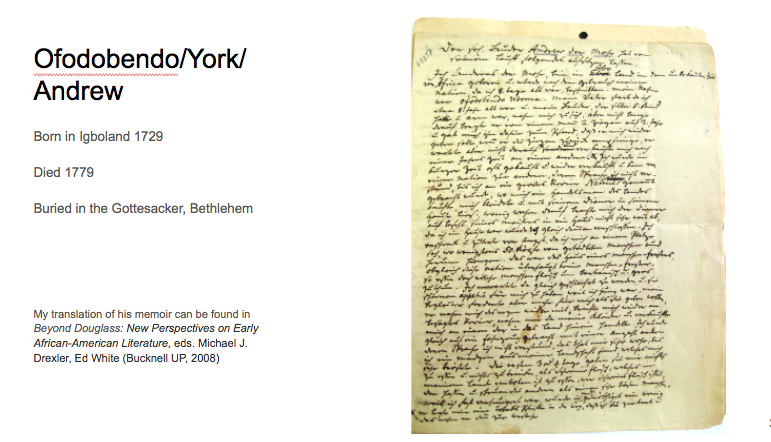
While recent scholarship has focused on knowledge transfer from African cultures to the Americas concerning inter alia rice production (see Judith Carney, Black Rice) there has to date been little work that traces the links between the technology of iron production in West Africa and the small Colonial iron forges of the mid-Atlantic region. This paper asks the question about the connection between labor practices in the nascent Colonial iron industry, enslaved peoples of African descent, and the networks of itinerant (Euro- and African-American) Moravian preachers in the mid-Atlantic area in the mid-18th century.
Using the methodologies of archival research, GIS mapping and network theory, this paper reveals the relationships between enslaved African populations of the Delaware Valley, iron production, and the organization of African American congregations in Philadelphia and New York, and attempts to trace the way in which these populations were agents of material and spiritual change for peoples of African descent in the Colonial mid-Atlantic
There are two beginnings to this paper. One lies in a manuscript memoir I found in the Moravian archives in Bethlehem about 25 years ago that was written by a 20 year old Igbo man who gave his name as Ofodobendo Wooma. The first line caught me: “I, Andrew the Moor, was born in Ibo land in the unknown part of Africa and was circumcised according to the custom of my nation when I was eight days old. My name was Ofodobendo Wooma.”
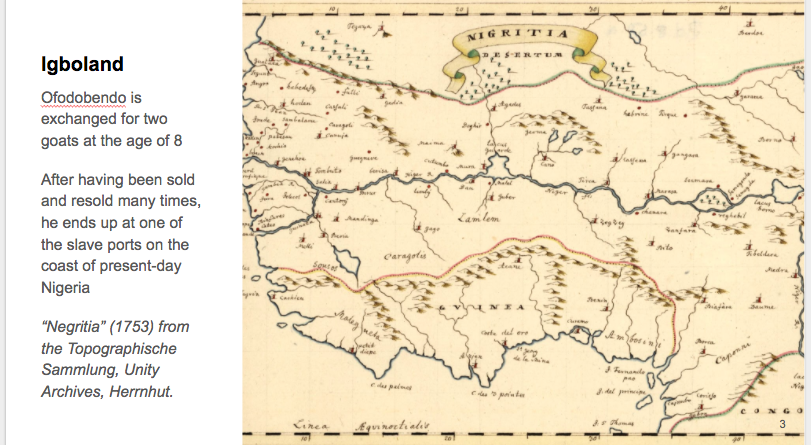
At that time, I carried out extensive research into the history of West Africa, especially Igboland, to try to understand the context into which I could place this unique document. At that time I was also working on the volume that would become “Moravian Women’s Memoirs” and had already found, transcribed, and translated Magdalene’s memoir, written/dictated by the woman from West Africa who would become Andrew’s wife in 1762. The discovery and subsequent discussion in print of that document invited me into the Atlantic world of the 18th century through African eyes. My article on this memoir and that of Ofodobendo’s later wife, Magdalene, also from West Africa, placed the life writings of these two enslaved Africans firmly within the genre of the slave narrative and traced how Ofodobendo signified (to use Henry Louis Gates’ term) his life in the tropes of the Christian conversion narrative. That interpretive path led me into an examination of that other very famous Igbo life narrative, Olaudah Equiano, the authenticity of which has been most famously challenged by Vincent Carretta. Even prior to Caretta’s work, I had noted with interest that the first chapter of that work echoed or actually quoted Anthony Benezet’s description of the coast and inland of West Africa in his widely read abolitionist work. Where I wondered had Benezet learned about West Africa? From the Africans on the quayside in Philadelphia? From his daughters who lived in Bethlehem as members of the Single SIsters Choir and who lived with Magdalene? And as I began to dig deeper it became more and more clear that the networks of the Colonial period between Quakers, Africans, Moravians, were strong and influential.
The story of Andrew/York/Ofodobendo Wooma is an exciting find. Although the exact date of composition of his memoir is not known, it breaks off after his baptism in 1746, which would mean that he may well have told his life story at the age of 17. His childhood memories are still fresh, telling of how, at the age of 8 he was exchanged for two goats by his brother, and then sold and resold many times before he was transported on a slave ship to Antigua, sold to a captain from New York, sold again and then again. At the age of about 12, Ofodobendo–now named “York”– was purchased by Thomas Noble, a wealthy merchant in New York with whom the Moravians were well acquainted and with whom members of the congregation who were traveling between Europe and North America would stay. This is of course the New York of the infamous “Slave Rebellion” and one wonders, when York describes his life running the streets, how many of the enslaved Africans he met. However, York is deeply affected by the faith and love of the Moravians in New York City and begs to be allowed to go to Bethlehem and be baptized. And then, after numerous entreaties and twists of fate and circumstance, he ends up as the property of Spangenberg in 1746 and is accepted into the congregation in Bethlehem.
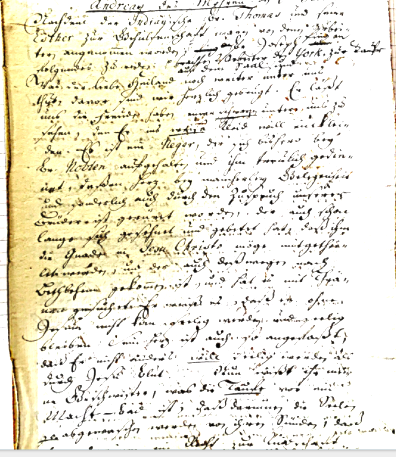
Andrew’s baptism was the first of an African by the Moravians in Pennsylvania. The fact of his being the first such fruit meant that a description and indeed transcription of his baptism was sent to Herrnhut. On February 4, 1746, Spangenberg (his owner) opens the ceremony with these words: “Was der liebe Heiland noch weiter unter uns thut, davor sind wir herzlich gebeugt. Er lässt uns die Freude haben , einen schwarzen unter uns zu sehen, den Er ins weisse Kleid will einkleiden.“
We are humbly prostrate before the works of the dear Saviour among us. He has given us the joy of seeing a Black man among us, whom He wants to dress in white robes.”
Spangenberg then goes on to ask whether Andrew wishes to be baptized and performs the rite of exorcism and then baptism
Frage: Is this yet the Desire of thy Heart to be baptized in the Name of Jesus Christ?
York gab Antwort. Yes.
Frage. Wilt thou be saved by that Blood which he has shed on the Cross?
Antwort yes
Frage, wilt thou be ruled by our Saviour and follow his Steps?
Antw. Yes.
Now our blessed Saviour is so gracious and loving to Sinners that whoever will be helpd, and wants to be set free from Satan and all his Power, such a one may be free in the Name of Jesus.
Ges. O Jesu Christ all Praise to thee
Die Gemeine stund auf u. Br. Joseph trat zum Täufling und sprach:
In the Name of our Lord and Master Jesus Christ who has purchased thee with his Blood, that thou dost not belong to the Devil and the World. But thou art his’n. In this pow’rful Name I command all/// the evil Powers to depart from thee (and leave thy heart to be his Temple and Habitation) and in His name thy Sins are Forgiven unto thee
Why was there such joy to see Andrew, the Black man in the white baptismal robes? Why was this account so carefully transcribed and sent to Herrnhut to Zinzendorf? Most obviously, Andrew’s baptism was a milestone in the success of the Bethlehem congregation in fulfilling its mission to proselytize to the enslaved and indigenous populations of North America. Andrew’s desire to join the Moravian congregation was the direct result of hearing the preachings of Awakened ministers, such as George Whitefield, and lay people in New York. But, as I have argued elsewhere, Andrew may well have had his own reasons for wishing to join the Moravians.
Andrew may well have been the Erstling, but he was not the only African to join the Bethlehem and Nazareth communities.
And here we come to the second beginning of this paper. About two years ago I was asked to give an interview to the Moravian Historical Society on Andrew as a new exhibition was being mounted on “Other Voices” in the Moravian settlements of Bethlehem and Nazareth, and Andrew was to be featured as a representative of the enslaved and free Africans and people of African descent in the colonial period. So I looked into the Moravian Archives again for documents about enslaved people and came across a travel diary by Brother Christian Froehlich which recounted his visit to the “Negroes of Brunswick and Long and Staaten Island in February and March 1752. ”
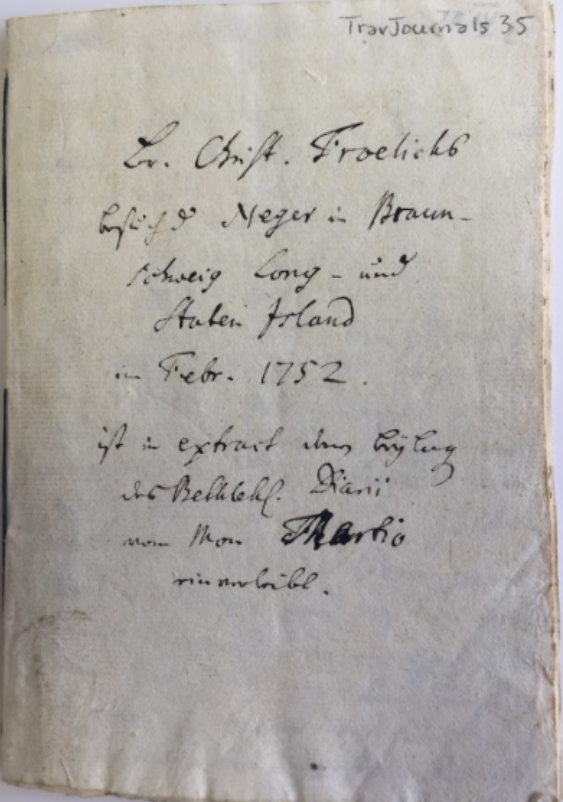
The Moravians had a mission not only to the Native Americans of Pennsylvania and New York but also to the enslaved peoples of the mid-Atlantic. Prominent in this mission was Christian Froehlich, an itinerant preacher, whose “Plan” it was to visit the enslaved Africans who were living on the Eastern seaboard, from the plantations of Virginia’s Tobacco Coast up through Maryland, New Jersey, Pennsylvania, and New York. In the northern states, many enslaved Africans worked in the forges of Colonial America’s early iron industry, where the iron ore in the hills was extracted and forged into pig iron for export back to England.
Froehlich’s earlier travel journals of his preaching trips to the enslaved peoples of the mid-Atlantic reveal many things: the frequent antipathy and suspicion in the south towards the very goal of the Moravian itinerant preachers along the King’s Waggon Road; the logistical difficulties that needed to be surmounted ; passes that needed to be obtained from the local justices; permission to meet with the enslaved peoples on the plantations or foundries; and fortitude and patience to traverse enormous physical distances, crossing rivers, swamps, and the Chesapeake Bay. These experiences I had already encountered in an earlier 1747 travel diary in which he described his attempt to visit the enslaved peoples on the tobacco plantations on the western shore of the Chesapeake Bay. that had been the focus of a DH class here at Bucknell.
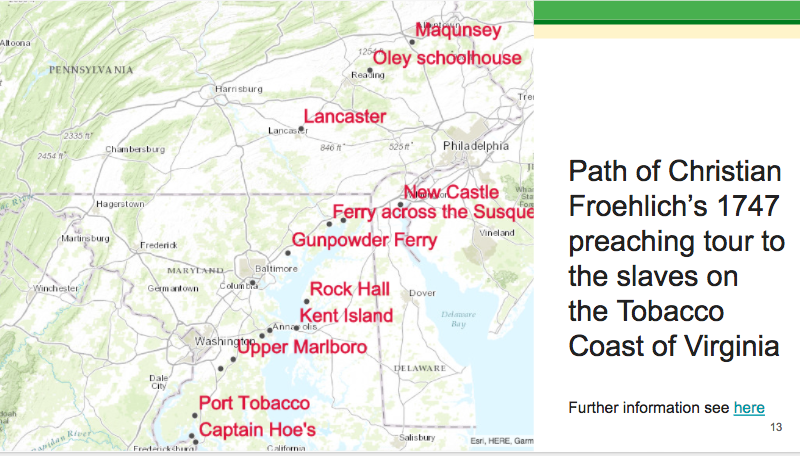
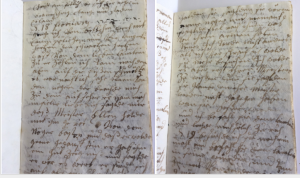 This 1752 document, however, described Froehlich’s visit to the enslaved Africans of New Jersey and New York, a subject that within Moravian studies has hardly been touched at all. Where there are studies of race and religion, they are of the South and rarely mention the populations of Africans living in the mid-Atlantic. Froehlich’s first stop on his journey is to the “Eisen Schmelze” or iron foundry near Bethlehem, the Durham furnace, owned by Mr Wiliam Allen. He describes his meetings with Africans working in the iron industry. He writes: That evening I came to the Iron Forge. It was night. I saw one of the Negroes who brought me to the overseer. He accepted me in all friendliness. He told me that Master Ellen (William Allen) had spoken to him about the Negro Boston and that he wanted to be baptized. He gave him a good report and said he was worthy. He was looking forward to becoming a Christian. Yes, much more than the so-called Christians. He could trust them all. He had Boston brought to him. He was happy to see me. When I told him that he should be baptized he was beside himself. After supper, I visited the Negroes in their house. I told them something about the dear Lamb and how much he loved also the hearts of the Black people, and that He had spilt his Blood for them also. They were very quiet and attentive and asked me to visit them more and hold an assembly for them. They said they were poor Negroes and nobody asked after them much, and about the welfare of their poor souls. I could do nothing but promise them to visit them more often. But I first had to let their masters know. They said they thought their masters would have nothing against it, if they improved themselves, so I commended them to the little Lamb and laid myself happy down to sleep.
This 1752 document, however, described Froehlich’s visit to the enslaved Africans of New Jersey and New York, a subject that within Moravian studies has hardly been touched at all. Where there are studies of race and religion, they are of the South and rarely mention the populations of Africans living in the mid-Atlantic. Froehlich’s first stop on his journey is to the “Eisen Schmelze” or iron foundry near Bethlehem, the Durham furnace, owned by Mr Wiliam Allen. He describes his meetings with Africans working in the iron industry. He writes: That evening I came to the Iron Forge. It was night. I saw one of the Negroes who brought me to the overseer. He accepted me in all friendliness. He told me that Master Ellen (William Allen) had spoken to him about the Negro Boston and that he wanted to be baptized. He gave him a good report and said he was worthy. He was looking forward to becoming a Christian. Yes, much more than the so-called Christians. He could trust them all. He had Boston brought to him. He was happy to see me. When I told him that he should be baptized he was beside himself. After supper, I visited the Negroes in their house. I told them something about the dear Lamb and how much he loved also the hearts of the Black people, and that He had spilt his Blood for them also. They were very quiet and attentive and asked me to visit them more and hold an assembly for them. They said they were poor Negroes and nobody asked after them much, and about the welfare of their poor souls. I could do nothing but promise them to visit them more often. But I first had to let their masters know. They said they thought their masters would have nothing against it, if they improved themselves, so I commended them to the little Lamb and laid myself happy down to sleep.
From there Froehlich travels into New Jersey to several other foundries to speak to the Black iron workers, then on to New York, Long Island, Staaten Island to speak to the enslaved peoples who were owned by the Van der Bilt’s and the Van Flecks.
So why was Froehlich’s first stop at the Durham Foundry to discuss the baptism of Baston? I wanted to find out more about this man, so I began to work my way through the baptismal records in the archives for the first 60 years of the community.
According to his memoir and also the baptismal register, Baston or Boston was born in approximately 1715 in Santa Crux, Guinea and was sold at around the age of 13 by his own people to slavers. At that age he endured the Middle Passage with about 300 of his people and was brought to Charlestown in South Carolina. There, according to his memoir, he was bought by a ship’s captain because of his being so handsome and taken to England the year that George II ascended the throne (1727). In 1732 he came back across the Atlantic to Monserrat in the West Indies where he was sold to an American and brought to Durham Furnace in Pennsylvania. It was here, as the property of William Allen, that he married Hannah, the property of the Ysselstein family who had just moved to Bethlehem. This marriage was difficult not least because Boston could see Hannah only when on the weekend he could walk the eight miles from the furnace to Bethlehem to see Hanna. However they had a son, Daniel. Baston was moved by Allen to Maryland to work in a furnace there, but was returned to the Delaware Valley once Allen met Hannah and the child.
So this was the reason Christian Froehlich was visiting the Durham Furnace. Baston, having visited Bethlehem several times, wanted to be baptized. Froehlich was securing his owner’s permission for baptism, which then happened on May 16, 1752 a few months after Froehlich’s visit.
Baston is baptized as Joseph and, after the congregation collects 50 pounds to buy him from William Allen, he is able to join his wife in the congregation. Hannah and Joseph have seven children, none of whom have children. Hannah is bought by the congregation and they require Joseph to pay the interest on the loan for her freedom. If he doesn’t she will be returned to the Ysselsteins.
So what about Andrew? At the end of his memoir the choir helper mentions the fact that he likes to speak with his countrymen about being saved. What however is not mentioned is that at the synod in Germantown in 1747 Andrew petitioned to be Christian Froehlich’s assistant in his ministry to the Africans of the Delaware Valley. In fact, according to the Single Brethren’s Diary Andrew not only visits the slaves in the iron forges of the Delaware Valley, he also goes to Philadelphia in 1749 where he works as the Spiritual Helper of the Black population there.
What effect might Andrew’s ministry have had on both Baston working in the Durham Forge and the other Africans in Philadelphia? According to John Catron, Andrew made numerous trips to Philadelphia between 1748 and 1753, some with either Christian Froehlich or with Brother Boemper and some alone, at times for up to four months. His work in the city seems to have had some effect on the Black population. 25 Black men and women appear in the Philadelphia Moravian church registers at that time, only six of whom were enslaved peoples. The Black members identify themselves as “Igbo”, or from “Guinea” or from St Croix.
That Andrew would have attracted Igbo to the church is not surprising as in later records it is shown that he preferred to keep networks of his “Landsleute” alive and would use Igbo to speak to other Igbo in the Delaware Valley and Philadelphia. In fact, in 1762 he asks to leave Bethlehem so that he can go to these countrymen and live.
African-Iron Forges
In the scholarly literature on the colonial mid-Atlantic iron industry it has been claimed that the Underground railroad, that knowledge network of safe places on the road up North to freedom, would frequently pass by iron forges because of the large African labor force that was known to be working there. In 1752, Christian Froehlich makes a point to visit the forges near Bethlehem where the production of iron necessitated large amounts of timber to be felled and a plentiful supply of freshwater close to the source of the iron ore. One contemporary visitor to the Durham Furnace where Joseph/Boston is working marvels at how efficient the forge is in production as all necessary raw materials are within a close distance from each other and no lengthy hauling is necessary.
For many historians of the Colonial mid-Atlantic iron industry the presence of enslaved Africans is a passing footnote, mentioned as part of the issues with the lack of a skilled and unskilled labor force to work in the industry. However, there is also evidence that the enslaved Africans, such as Joseph/Boston came from West African cultures where the production of iron had been an integral part of the social and economic culture of their societies for centuries. Where the production of iron was embedded in the traditional religions of the Igbo people from whom Andrew came, for example. There is evidence for iron production in West Africa since the 6th century, with major shrines around Ife to the god of iron “Ogun”. Within these traditional religions, the forge was considered to be a female space, to be worked only by a male forgemaster, although women were permitted to perform other tasks outside the forge. (http://www.metmuseum.org/toah/hd/iron/hd_iron.htm)
Thus the iron forges of the Delaware Valley were the location of high densities of African enslaved workers, and thus also one of the destinations of Andrew and Froehlich. In the scholarship on labor history in Pennsylvania in the colonial period, researchers have pointed out the problems ironmasters had in keeping white workers in the forges. Pay, hard work and tough conditions coupled with the distance from urban centers all meant that free labor moved away from iron centers quickly. Thus forge owners such as William Allen looked to their enslaved workers to produce iron. However, although earlier scholarship assumed that enslaved Africans would be forced to perform the hard and unskilled labor of extracting and preparing the raw materials, more recent research into the Delaware Valley iron industry draws a contrast with the more southerly Chesapeake iron production industry. In the Delaware Valley ironmasters trained their African workers to refine and draw iron in their forges, to the point, as John Bezis-Selfa argues “that slaves were disproportionately represented among forgemen.” (J. Bezis-Selfa, 277) The presence of so many highly skilled African forgemen has led to speculation that African metallurgical skills played a large role in this phenomenon. Indeed this is another instance of knowledge transfer from Africa to North America.
Looking at the map of West Africa again, this time with the identification of sites of iron making, we see the correlation with Andrew and Joseph’s origins.
Iron had been worked in West Africa since at least 500 CE and European travellers in Africa such as Mungo Park noted the smiths there used tools and methods similar to those in British North America. It is also not lost on me that Bethlehem was to become the site of the largest blast furnaces in the country.
Investigation into Andrew as a paradigmatic figure for the diverse voices in early Bethlehem and Nazareth is a vital step towards asking further questions. There is by some the assumption that slaves would only perform menial forced labor, both in the congregation and outside. But to claim that is to prolong the prejudiced assumption that Africans could only perform menial tasks and brought with them no skilled knowledge from their homelands. That, I argue is an error.
The Helpers Conference minutes show lengthy and in depth discussions about the best way to ensure that EVERY member of the congregation could fulfill God’s (and the Congregation’s) “Plan” for them. Subject to the way in which the Lot decided, like every other member of the Congregation, Africans worked in Bethlehem in the colonial industries, trades, and choir houses. BUT they could also become instrument makers and preachers. They could hold firearms during times of trouble. They were also educated and valued for their national knowledge. Hence Andrew’s “Plan, after baptism, to be Christian Froehlich’s Helper and preach to his “Landsleute”.
Primary Sources
- “Andrew”, “Josua” “Magdalene” “Rebecca” Memoirs, Moravian Archives, Bethlehem
- Bethlehem Diary, vols, 7, 16, 17, 27, Moravian Archive, Bethlehem
- Single Brethren’s Diary, 1744-1752, Moravian Archives, Bethlehem
- Box marked Slaves, Moravian Archives, Bethlehem
- Travel Diary, Christian Froehlich, 1752
- Travel Diary, Christian Froehlich, 1744
Secondary sources
- John Bezis-Selfa, “Slavery and the Disciplining of Free Labor in the Colonial Mid-Atlantic Iron Industry” Pennsylvania History 64 (1997) 270-286
- Arthur Cecil Bining, Pennsylvania Iron Manufacture in the Eighteenth Century (PHMC, 1973)
- John Catron, “Early Black-Atlantic Christianity in the Middle Colonies: Social Mobility and Race in Moravian Bethlehem” Pennsylvania History 76.3 (2009), 301-345
- Katherine Faull, ““Self-Encounters: Two Eighteenth-Century African Memoirs from Moravian Bethlehem” in Crosscurrents: African-Americans, Africa and Germany in the Modern World, eds. C. Aisha Blackshire-Belay, Leroy Hopkins, and David MacBride (New York: Camden House, 1998), 29-52; reprinted in Michael J. Drexler and Ed White, Beyond Douglass: New Perspectives on Early African-American Literature, Aperçus: Histories Texts Cultures. Lewisburg: Bucknell University Press, 2008
- Michael Kennedy, “Working Agreements: The Use of Sub-Contracting in the Pennsylvania Iron Industry 1725-1789” Pennsylvania History 65.4 (1998), 492-508
- Anne Kelly Knowles, Mastering Iron: The Struggle to Modernize an American Industry 1800-1868 (University of Chicago Press, 2013)
- Theodore Kury, “Labor and the Charcoal Iron Industry: The New Jersey-New York Experience” Material Culture 25:3 (1993), 10-33.
- Jill Lepore, New York Burning: LIberty, Slavery, and Conspiracy in Eighteenth-Century Manhattan (Random House, 2005)
- Joseph Levering, A History of Bethlehem, Pennsylvania 1741-1892 (Times Publishing, 1903)
- Ronald Lewis, “Slavery on Chesapeake Iron Plantations Before the American Revolution” 59.3 (1974), 242-254
- Harry Stocker, A History of the Moravian Church in New York City, New York City, 1922
- John Thornton, A Cultural History of the Atlantic World 1250-1820 (Cambridge UP, 2012)
- Joseph Walker, “Negro Labor in the Charcoal Iron Industry of Southeastern Pennsylvania” The Pennsylvania Magazine of History and Biography 93.4 (1969), 466-486




